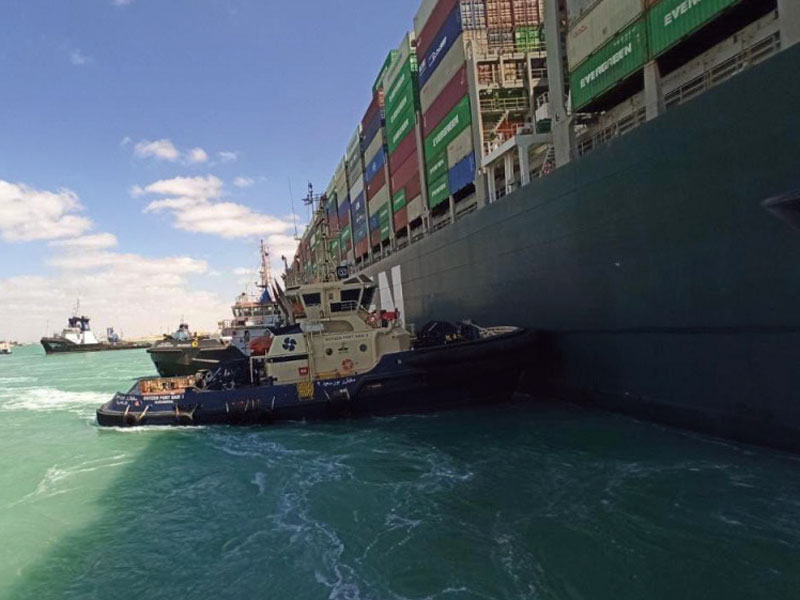After facing unforeseen events like the Ever Given and COVID-19, the bigger issue is what supply chains will do to decrease risk and increase resiliency.
Supply chains around the globe are governed by commercial contracts that require parties to perform certain acts, such as delivering goods, supplies, and equipment, within specific timeframes. What happens when unforeseen events intervene to make compliance impossible?
The ultimate effects of the Suez snafu will likely take some time to play out. Increased port congestion thanks to late arrivals and a further squeeze on container availability could have a negative impact on supply chains down the line. Longer term will be the economic damages suffered by companies, and the claims they are likely to make, as a result of the late arrival of cargo.
The COVID-19 pandemic has disrupted business activities on an even more profound scale, upending commercial transactions and leading to a myriad of legal claims. The disposition of many claims surrounding both situations will likely hinge on the applicability of force majeure—a legal doctrine that can excuse parties from contractual obligations when circumstances beyond their control intervene. Experts say that the doctrine could be applied even if a contract does not specify navigational problems or diseases as force majeure events. Going forward, supply chains must consider how they will cope with these kinds of extraordinary disruptions if and when they arise in the future.

Force Majeure and the Ever Given
The Evergreen Marine report that the Ever Given was “suspected of being hit by a sudden strong wind, causing the hull to deviate,” suggests that force majeure will likely be invoked by parties attempting to wriggle out of contracts. When force majeure comes into play, “obligations under bills of lading and charter parties” could be suspended, said Régis Broudin, global head of marine claims at Allianz Global Corporate & Specialty, “conceivably leading to termination of contracts.”
Building construction depends on timely deliveries, so force majeure will likely be invoked in litigation seeking damages caused by delays that negatively impacted projects. In most cases, according to Eric Ruzicka, a partner at the international law firm Dorsey & Whitney, force majeure “clauses will be silent on the specific question of whether shipping delays are excusable force majeure events.”
Courts considering similar claims “have generally held that extraordinary shipping delays may constitute force majeure,” Ruzicka said. But a party making such a claim must mitigate damages by sourcing materials from another supplier or making alternate shipping arrangements. The issue of mitigation may have led to the decision to route some backlogged vessels around Africa’s southern tip, as Hapag-Lloyd did for six of its twelve vessels idled as a result of the Ever Given blockage.
When it comes to COVID-19, some commercial contracts for fuel deliveries list health disasters such as disease, pestilence, and pandemics, as force majeure events, but many do not, according to Barry Schaps, a strategic partner at Stillwater Associates, a consultancy to the downstream oil industry. Some contracts include “a general catch-all force majeure provision adding other unforeseeable events beyond the parties’ reasonable control,” he explained. “If a pandemic is not specifically listed as a force majeure event in a contract, courts will determine if the financial chaos caused by the pandemic was unforeseeable at the time the parties entered into their contract and whether it caused sufficient disruption of the parties’ ability to perform their contract.”
Going Forward
Some supply contracts include natural disasters as force majeure events. A recent case in a federal court in New York provided cover for those seeking to claim COVID-19 as force majeure, when it stated that “by any measure, the COVID-19 pandemic fits those definitions.” The decision, according to Schaps, “opens a path for parties to make force majeure claims or defenses, when the contract clause identifies natural disasters as a force majeure event, even if the clause omits references to pandemics or diseases.”
Going forward, supply chain stakeholders, from shippers and receivers to carriers, third parties, and insurers, must face the bigger question of how they are going to react to future disruptions of the kind witnessed in recent weeks and months. The Ever Given incident, for example, is likely to cause losses for insurers on the order of hundreds of millions of dollars, according to Fitch Ratings, a U.S. credit rating agency, covering property damage, liability, and business losses.
Much has been made of boosting supply chain resiliency over the last year, as companies came to grips with the notion that they must be prepared for the unforeseen if they are to succeed. Reliance on the legal doctrine of force majeure may be a last ditch effort to stem losses, but it’s not a plan for the future. It’s also questionable whether incidents represented by the Ever Given and COVID-19 may any longer be considered unforeseen.
Maritime and commercial insurers have already recognized the increased risks inherent in operating ultra-large vessels. “There is disproportionately greater cost when things go wrong,” noted Rahul Khanna, global head of marine risk consulting at Allianz Global Corporate & Specialty. “Insurers have been warning for years that the increasing size of vessels is leading to a higher accumulation of risk.”
Those fears are now being realized in more frequent reports of large ships encountering difficulties navigating canals, according to Jonathan Moss, head of marine and trade at DWF, a provider of legal and business services. Operating the floating behemoths also requires “huge investment,” he said, for “associated infrastructure” such as deeper channels and larger cranes and storage facilities.
Insurance companies know what to do when risk goes up: they increase insurance premiums, and “the costs will be borne by end users, the purchasers of goods,” said Moss. Now, it is for other stakeholders to consider what they will do to lower risk and increase resiliency in their supply chains.





